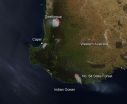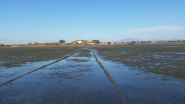(Press-News.org) Swedish and Chinese researchers show how a unique nano-alloy composed of palladium nano-islands embedded in tungsten nanoparticles creates a new type of catalysts for highly efficient oxygen reduction, the most important reaction in hydrogen fuel cells. Their results are published in the scientific journal Nature Communications.
The world's rapidly growing demand for energy and the requirement of sustainable energy production calls for an urgent change in today's fossil fuel based energy system. Research groups worldwide work intensively to develop novel advanced energy conversion and storage systems with high efficiency, low cost and environmental compatibility.
Fuel cell systems represent a promising alternative for low carbon emission energy production. Traditional fuel cells are however limited by the need of efficient catalysts to drive the chemical reactions involved in the fuel cell. Historically, platinum and its alloys have frequently been used as anodic and cathodic catalysts in fuel cells, but the high cost of platinum, due to its low abundance, motivates researchers to find efficient catalysts based on earth-abundant elements.
"In our study we report a unique novel alloy with a palladium (Pd) and tungsten (W) ratio of only one to eight, which still has similar efficiency as a pure platinum catalyst. Considering the cost, it would be 40 times lower", says Thomas Wågberg, Senior lecturer at Department of Physics, Umeå University.
The explanation for the very high efficiency is the unique morphology of the alloy. It is neither a homogeneous alloy, nor a fully segregated two-phase system, but rather something in between.
By advanced experimental and theoretical investigations, the researchers show that the alloy is composed of metallic Pd-islands embedded in the Pd-W alloy. The size of the islands are about one nanometer in diameter and are composed of 10-20 atoms that are segregated to the surface. The unique environment around the Pd-islands give rise to special effects that all together turn the islands into highly efficient catalytic hot-spots for oxygen reduction.
To stabilize the nanoparticles in practical applications, they are anchored on ordered mesoporous carbon. The anchoring keep the nanoparticles stable over long time by hindering them from fusing together in the fuel cell tests.
"The unique formation of the material is based on a synthesis method, which can be performed in an ordinary kitchen micro-wave oven purchased at the local supermarket. If we were not using argon as protective inert gas, it would be fully possible to synthesize this advanced catalyst in my own kitchen! ", says Thomas Wågberg.
Wågberg and his fellow researchers have recently received funding from the Kempe Foundation to buy a more advanced micro-wave oven, and therefore they will be able to run more advanced experiments to fine tune some of the catalyst properties.INFORMATION:
The Artificial Leaf
The study has been conducted within the artificial leaf project, which is funded by Knut and Alice Wallenberg foundation. Physicist, chemists, and plant science researchers at Umeå University work together in the search for clean and renewable energy sources.
Original article:
Guangzhi Hu, Florian Nitze, Eduardo Gracia-Espino, Jingyuan Ma, Hamid Reza Barzegar, Tiva Sharifi, Xueen Jia,Andrey Shchukarev, Lu Lu, Chuansheng Ma, Guang Yang, and Thomas Wågberg: Small palladium islands embedded in palladium-tungsten bimetallic nanoparticles form catalytic hot-spots for oxygen reduction. Nature Communications, 2014(5). DOI:10.1038/NCOMMS6253.
http://www.nature.com/ncomms/2014/141013/ncomms6253/full/ncomms6253.html
Unique catalysts for hydrogen fuel cells synthesized in ordinary kitchen microwave oven
2014-10-14
ELSE PRESS RELEASES FROM THIS DATE:
Fires dot the Ukraine countryside
2014-10-14
Numerous fires (marked with red dots) are burning in the Ukraine, likely as a result of regional agricultural practices. The body of water at the lower left of this true-color Moderate Resolution Imaging Spectroradiometer (MODIS) image is the Sea of Azov. The Sea is bordered by Ukraine to the northwest, west and southwest and by Russia to the northeast, east, and southeast. To its left is the Black Sea.
The location, widespread nature, and number of fires suggest that these fires were deliberately set to manage land. Farmers often use fire to return nutrients to the soil ...
Prescribed burns in Western Australia
2014-10-14
The Moderate Resolution Imaging Spectroradiometer (MODIS) on NASA's Aqua satellite detected fires burning in Western Australia on October 14, 2014. Matching these hot spots up to the the prescribed fire burns on Western Australia's parks and wildlife site: http://www.dpaw.wa.gov.au/management/fire/prescribed-burning/burns these fires are most likely prescribed burns used to limit bushfire outbreaks. According to the Government of Australia's Department of Parks and Wildlife, "Prescribed burning is the process of planning and applying fire to a predetermined area, under ...
Early detection window when pancreatic cancer is in the family
2014-10-14
Pancreatic cancer likely takes between 10 and 20 years to develop, providing the potential for a very "broad window" of intervention if detected early, which may be possible for people who inherit a predisposition, say Australian clinical researchers.
Dr Jeremy Humphris and Professor Andrew Biankin1, from Sydney's Garvan Institute of Medical Research, analysed medical histories and tumour samples taken from a cohort of 766 pancreatic cancer patients, operated on between 1994 and 20122. Roughly 9% of these patients had a first-degree relative (parent or sibling) with ...
Seniors run for the suburbs in their golden years
2014-10-14
Montreal, October 14, 2014 — By 2040, there will be more than three times the number of Americans aged 80+ than there were in 2000. Condo towers crowding city skylines seem to reflect builders' hopes that the grey set will head to urban centres for increased services and better transit options. But new research from Concordia University suggests that the opposite is more likely to occur.
In a study recently published in the Journal of Transport Geography, researcher Zachary Patterson uses census data to map seniors' moving habits. What emerges is a clear pattern: ...
NASA's Aqua satellite sees Extra-Tropical Storm Vongfong pulling away from Hokkaido, Japan
2014-10-14
NASA's Aqua satellite passed over Extra-Tropical Storm Vongfong on Oct. 4 as it was moving away from Hokkaido, Japan, the northernmost of the big islands. Vongfong transitioned into an extra-tropical storm early on Oct. 4 as its core changed from warm to cold.
The MODIS or Moderate Resolution Imaging Spectroradiometer instrument aboard NASA's Aqua satellite captured a visible image of Tropical Storm Vongfong over Japan on Oct. 14 at 03:15 UTC as it was southeast of the island of Hokkaido, Japan. The image showed that south of the center of circulation was almost devoid ...
Future computers could be built from magnetic 'tornadoes'
2014-10-14
Magnetic materials form the basis of most hard disc drives as they are able to store data. A team from the University of Sheffield's Faculty of Engineering have been investigating whether they could also be used to perform calculations, and so take on the role of a computer's central processing unit (CPU).
Lead researcher, Dr Tom Hayward, explains: "Magnetic materials are useful for data storage because they can retain information without consuming energy. A computer built around a CPU made of magnetic materials should be much more power efficient than existing technologies, ...
Institutional rearing may increase risk attention-deficit disorder
2014-10-14
Philadelphia, PA, October 14, 2014 – Over the past decades, we have seen numerous tragic examples where the failure of institutions to meet the needs of infants for social contact and stimulation has led to the failure of these infants to thrive.
Infancy and childhood are critical life periods that shape the development of the cortex. A generation of research suggests that enriched environments, full of interesting stimuli to explore, promote cortical development and cognitive function. In contrast, deprivation and stress may compromise cortical development and ...
New discovery will enhance yield and quality of cereal and bioenergy crops
2014-10-14
ST. LOUIS, MO – October 13, 2014 –A team of scientists led by Thomas Brutnell, Ph.D., director of the Enterprise Rent-A-Car Institute for Renewable Fuels at the Donald Danforth Plant Science Center have developed a new way of identifying genes that are important for photosynthesis in maize, and in rice. Their research helps to prioritize candidate genes that can be used for crop improvement and revealed new pathways and information about how plants fix carbon. The findings, published in "Comparative analyses of C4 and C3 photosynthesis in developing leaves of ...
Scientists link ALS progression to increased protein instability
2014-10-14
LA JOLLA, CA—October 13, 2014—A new study by scientists from The Scripps Research Institute (TSRI), Lawrence Berkeley National Laboratory (Berkeley Lab) and other institutions suggests a cause of amyotrophic lateral sclerosis (ALS), also known as Lou Gehrig's disease.
"Our work supports a common theme whereby loss of protein stability leads to disease," said John A. Tainer, professor of structural biology at TSRI and senior scientist at Berkeley Lab, who shared senior authorship of the new research with TSRI Professor Elizabeth Getzoff.
Getzoff, Tainer and ...
Taking infestation with a grain of salt
2014-10-14
Twenty years ago, biologists Kathy Boyer and Joy Zedler, then researchers at San Diego State University, speculated that too many insects feeding on cordgrass in the marshes of San Diego Bay could endanger the grass, and in turn endanger the bay wildlife that relies on it.
Picking up where Boyer and Zedler left off, SDSU biologist Jeremy Long is currently further exploring the dimensions of this relationship. What he's found so far suggests that it's not a simple as saying too many insects spell death for a host plant. Instead, his research suggests a complex interplay ...






